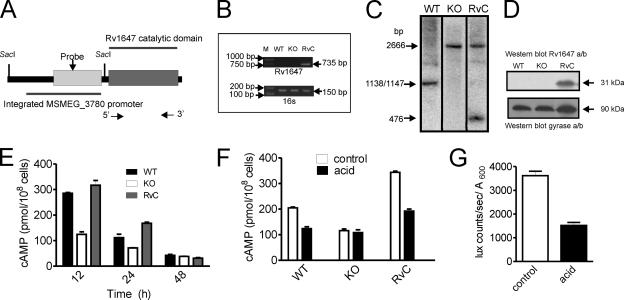FIG. 6.
Characterization of the ΔMSMEG_3780 strain complemented with Rv1647. (A) Diagrammatic representation of the DNA inserted into the ΔMSMEG_3780 strain containing the MSMEG_3780 promoter driving the expression of the catalytic domain of the Rv1647 gene. The SacI sites used for analysis are shown, and arrows indicate the positions of primers used for PCR. (B) PCR analysis of genomic DNA prepared from the wild-type (WT), knockout (KO), and complement (RvC) strains using Rv1647-specific primers. Also shown is a PCR of the genomic DNA with primers specific to the 16S gene. (C) Southern blot analysis of the DNA prepared from wild-type, knockout, and complement strains was performed following SacI digestion. The probe used was a region present in the MSMEG_3780 promoter. The fragments hybridizing in wild-type and knockout genomic DNAs are identical to those shown in Fig. 3, while a convenient SacI site that was introduced into the Rv1647 fragment used for integration allowed the detection of a unique fragment in complement genomic DNA. (D) Western blot analysis using membranes prepared from wild-type, knockout, and complement strains at 30 h of growth. Total protein (50 μg) in the blot was normalized using an affinity-purified antibody to Rv1647 and a monoclonal antibody to the gyrase A subunit. (E) Intracellular cAMP levels were measured in the wild-type, knockout, and complement strains. Data shown are the means ± SEM of duplicate determinations of experiments performed twice. (F) Intracellular cAMP levels in wild-type, knockout, and complement strains following acid stress for 5 h. Values shown are the means ± SEM. (G) The Rv1647 promoter was fused to luxAB, and the promoter activity was measured in control cells and cells cultured under acidic conditions for 5 h. Data shown represent the means ± SEM of duplicate determinations of experiments performed twice.

